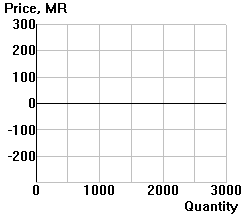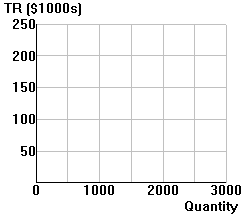| 3. |
Suppose your firm's demand (D) is given by:
Q = 3000 - 10P. |
 |
|
a. |
What is the equation for your inverse demand function?
|
|
b. |
What is the equation for your total revenue (TR)?
|
|
c. |
What is the equation for your marginal revenue
(MR)?
|
|
d. |
Use values from your equations above to
complete the following table and then plot your demand curve and marginal revenue curve in the top
righthand diagram, and plot your total revenue curve in the diagram below it. |
 |
| Q |
P ($) |
MR ($) |
TR ($1000) |
| 0 |
|
|
|
| 500 |
|
|
|
| 1000 |
|
|
|
| 1500 |
|
|
|
| 2000 |
|
|
|
| 2500 |
|
|
|
| 3000 |
|
|
|
|

